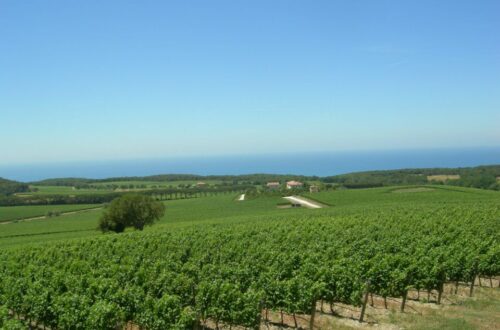Table of Contents
What is Bianco dell’Empolese DOC? – Quick Answer
Bianco dell’Empolese DOC is a Tuscan white wine appellation established in 1989, covering six municipalities in Florence province including Vinci—Leonardo da Vinci’s birthplace. Made primarily from Trebbiano Toscano (minimum 60%), it produces fresh white wines and the region’s most famous sweet treasure: Vin Santo, aged three or more years in small barrels.
Key Facts
- Established: 1989 (DOC status)
- Location: Florence province, including Vinci (Leonardo’s birthplace)
- Main Grape: Trebbiano Toscano (≥60%)
- Wine Styles: Dry Bianco & Vin Santo dessert wine
- Famous For: Leonardo da Vinci wine connection & Tuscan Vin Santo
History and Origins
While the DOC is relatively young (1989), wine in this part of Tuscany has been made for centuries. The Empolese zone, hugging the Arno River Valley, supplied wines to nearby Florence during the Renaissance. Records show Trebbiano wines being sent to Florence’s elite tables, and Vin Santo was often poured at religious and celebratory occasions. The connection to Leonardo da Vinci, who was born in Vinci in 1452, adds a cultural and storytelling dimension few other Italian wines can rival.
Where It’s Made: Geography & Terroir
Bianco dell’Empolese DOC lies west of Florence, around Empoli, Vinci, Cerreto Guidi, and Montelupo Fiorentino. The soils here are a mix of alluvial sand and clay, shaped by the Arno River, which provides fertile conditions ideal for Trebbiano. The Mediterranean climate ensures warm summers and mild winters, with good diurnal shifts that help retain freshness in the wines.
The Grape (or Blend)
Bianco dell’Empolese must be made with at least 60% Trebbiano Toscano, often blended with Malvasia Bianca, Verdello, or other local white grapes. For Vin Santo, Trebbiano and Malvasia are harvested late, then dried on straw mats before slow fermentation and aging in small oak or chestnut barrels.
Winemaking & DOC Regulations
- Bianco dell’Empolese DOC: Min. 60% Trebbiano Toscano, up to 40% other approved white grapes.
- Vin Santo dell’Empolese DOC: Grapes must be air-dried before pressing; aged min. 3 years in small barrels (caratelli).
- Alcohol levels: 10.5% minimum for Bianco; 16% for Vin Santo.
- Superiore wines: Stricter yield and alcohol requirements for higher quality.
Tasting Notes
- Bianco dell’Empolese (Dry White): Light-bodied, crisp, fresh, with aromas of white flowers, green apple, and citrus. Perfect for aperitivo or seafood dishes.
- Vin Santo dell’Empolese: Amber-gold, with flavors of dried apricot, honey, walnut, and caramel. Rich but balanced, traditionally paired with biscotti di Prato.
Serving & Pairing
- Bianco dell’Empolese: Serve chilled (8–10°C). Ideal with Tuscan seafood dishes, panzanella, fresh pecorino, or simple grilled vegetables.
- Vin Santo dell’Empolese: Serve slightly cool (12–14°C) in small glasses. Classic with cantucci, but also works beautifully with foie gras, blue cheeses, or roasted almonds.
Leonardo da Vinci’s Wine Region: Visiting Vinci Wineries
The Bianco dell’Empolese DOC zone includes Vinci, Leonardo’s birthplace. Today, visitors can blend Renaissance history with Tuscan wine exploration.
- Cantine Leonardo da Vinci: Historic cooperative producing both Bianco and Vin Santo, continuing the area’s centuries-old wine tradition.
- Day trips from Florence: Just 45 minutes by car, Vinci offers the perfect blend of wine country landscapes and cultural discovery.
- Experiences: Visit the Leonardo da Vinci Museum, walk through vineyards he would have known, and taste wines that carry his homeland’s DNA.
Best Bianco dell’Empolese Producers & Wineries
- Cantine Leonardo da Vinci – The flagship winery of the appellation.
- Fattoria di Petrognano – Family-run estate known for quality Vin Santo.
- Tenuta di Baccio – Produces boutique Empolese whites with local character.
Bianco dell’Empolese vs Other Tuscan White Wines
Unlike Vernaccia di San Gimignano DOCG (mineral and structured) or Pomino Bianco DOC (often oak-aged with Chardonnay), Bianco dell’Empolese is lighter, fresher, and more tied to Trebbiano. Its Vin Santo is among Tuscany’s most authentic sweet wines, rivaling those from Chianti Classico or Carmignano.
Where to Buy & Pricing
- Italy: Widely available in Florence and Vinci wine shops.
- International: Cantine Leonardo da Vinci distributes worldwide. Expect €8–12 for Bianco, and €20–35+ for Vin Santo.
- Online Retailers: Wine.com, Vivino, and Italian specialty importers.
Wine Tourism: Florence to Empoli Day Trip Itinerary
- Morning: Depart Florence, visit Montelupo Fiorentino ceramics town.
- Lunch: Traditional trattoria in Vinci with Bianco dell’Empolese pairings.
- Afternoon: Leonardo Museum + Cantine Leonardo wine tasting.
- Evening: Return to Florence for dinner with Vin Santo & cantucci.
FAQ on Bianco dell’Empolese DOC
- How much does Bianco dell’Empolese cost? Around €8–12 for a bottle.
- What’s the best vintage? Consistent, but 2016 and 2020 stand out for freshness.
- Is Vin Santo worth buying? Yes—Empolese Vin Santo is a hidden gem with excellent value.
- Can you visit Leonardo da Vinci wineries from Florence? Yes, Vinci is just 45 minutes away.
- What makes it different from other Tuscan whites? More Trebbiano-driven, with a strong Vin Santo tradition.
- How long does Vin Santo age? Minimum 3 years, though many age 5–10 years.
- Does Leonardo da Vinci have a wine connection? Yes—he was born in Vinci, the heart of this DOC, and local cooperatives honor his legacy.
Fun Facts & Cultural Notes
- Leonardo the Winemaker? Records suggest his family owned vineyards in Vinci.
- Vin Santo Legend: Traditionally, barrels were sealed and forgotten in the attic until Easter, symbolizing rebirth.
- Pairing with Art: Some Florence wine tours now offer combined “Leonardo & Vin Santo” tastings.
CTA for Audience Engagement
👉 Planning a trip to Tuscany? Subscribe to our newsletter for curated wine itineraries and exclusive tips on Leonardo da Vinci’s wine country.


